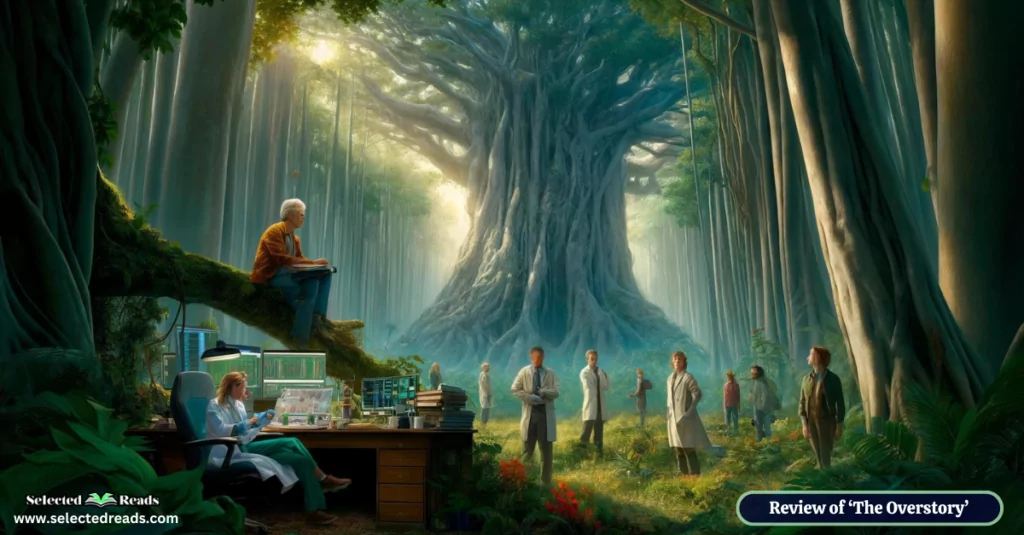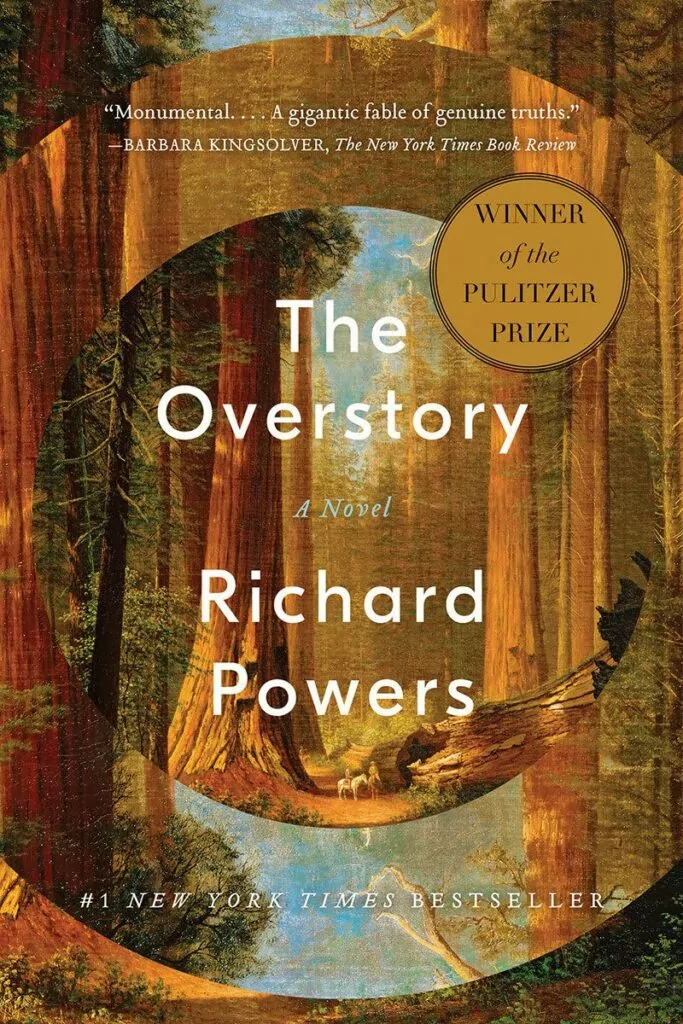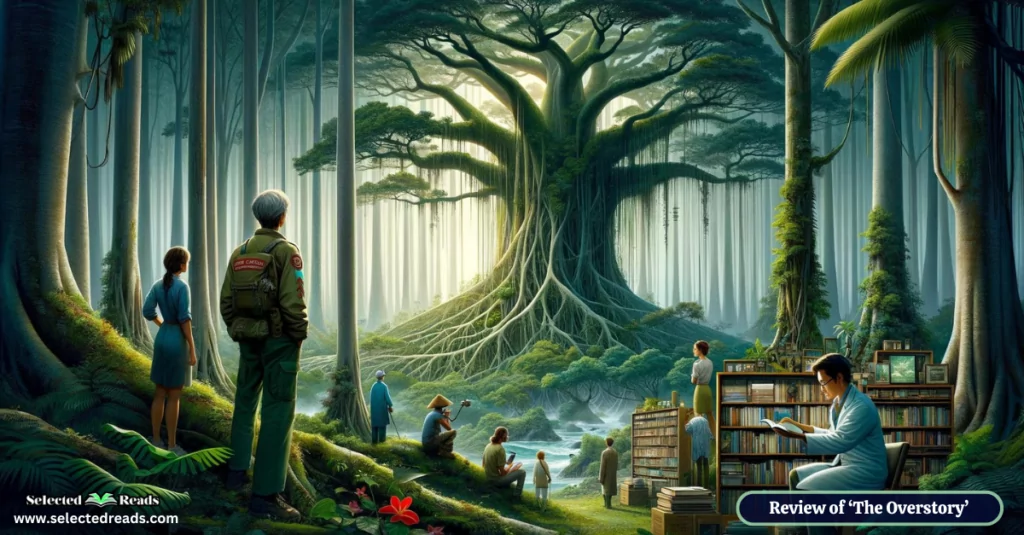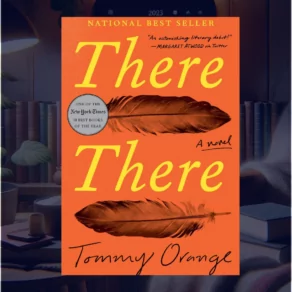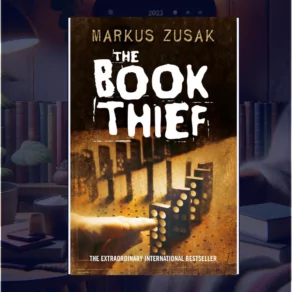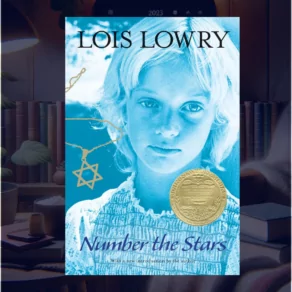I have something special today for fans of deeply moving environmental fiction: “The Overstory” by Richard Powers. The purpose of this post is to familiarize you with this Pulitzer Prize-winning novel without spoiling too much of its richly woven tapestry. My discussion will proceed as follows:
First, I provide a summary of the novel to set the stage for those who haven’t read it yet. Next, I discuss the diverse and vibrant characters that bring this story to life. To wrap up, I’ll offer some thought-provoking book club questions that can help deepen your understanding and appreciation of this complex narrative.
The Overstory Summary
“The Overstory” by Richard Powers is a complex and multi-layered novel that intertwines the lives of its characters through their unique connections to trees and forests, portraying a deep and intricate narrative that explores the relationship between humans and the natural world.
The story unfolds in four major parts: “Roots,” “Trunk,” “Crown,” and “Seeds.” Each part builds upon the other to weave a comprehensive tale about the impact of trees on the lives of the characters and the environmental issues affecting our planet.
Roots: This section introduces us to nine main characters, each with their own standalone story, connected by their personal experiences with trees. These characters include Nicholas Hoel, a descendant of Iowa farmers who witnesses the destruction of his family’s chestnut trees; Mimi Ma, who inherits ancient scrolls that survived her father’s death by hiding in a mulberry tree; Adam Appich, a boy fascinated by psychology and the behaviors influenced by nature; Ray Brinkman and Dorothy Cazaly, a couple who spend their lives cataloging nature; Douglas Pavlicek, a Vietnam veteran saved by a banyan tree after his plane is shot down; Neelay Mehta, a paraplegic computer game designer inspired by the majestic trees of Stanford; Patricia Westerford, a scientist who discovers that trees communicate with each other; and Olivia Vandergriff, who experiences a near-death experience that connects her deeply with nature.
Photo: Amazon
Trunk: As the stories of these characters converge, they form a group motivated by a desire to save America’s few remaining acres of virgin forest. This part focuses on their activism and efforts to protect the trees from logging and destruction. Their actions range from legal battles to direct action and eco-terrorism, showing the complexities and moral ambiguities of environmental activism.
Crown: The narrative extends as the characters face the consequences of their actions. Their lives are transformed by their dedication to the cause, affecting their personal relationships, careers, and ultimately their destinies. The bond among them, strengthened by shared convictions and conflicts with external powers, reveals the profound emotional and physical impact of their fight against environmental exploitation.
Seeds: In the final part of the novel, the earlier efforts of the characters see some fruition, albeit often symbolic or bittersweet. The story reflects on the regeneration and resilience of nature, suggesting a hopeful yet cautionary note about the future of human interaction with the environment. The characters’ legacies are mirrored in the survival and spread of seeds, symbolizing new beginnings rooted in the sacrifices and contributions of the past.
Related: Interpreter of Maladies Summary and Book Club Questions
Through “The Overstory,” Richard Powers encapsulates a broad and poignant exploration of environmental consciousness, weaving human narratives into the larger life story of Earth’s forests. The novel serves not only as a compelling saga of its characters but also as an urgent call to recognize and preserve the natural world that sustains us all.
The Overstory Characters
In Richard Powers’ “The Overstory,” the characters are deeply drawn, each with a unique backstory that intertwines with the novel’s overarching theme of trees and environmentalism. Here’s a closer look at the main characters and their roles:
- Nicholas Hoel – A descendant of a long line of farmers from Iowa, Nicholas is connected to a chestnut tree planted by his ancestors. The tree serves as a focal point for his family’s history and eventual participation in the environmental movement.
- Mimi Ma – The daughter of a Chinese immigrant who treasures ancient scrolls saved from destruction by being hidden in a mulberry tree. Mimi’s life is transformed by her deep connection to these trees and her father’s legacy, leading her into environmental activism.
- Adam Appich – A budding psychologist intrigued by how trees can influence human behavior and community dynamics. Adam’s academic interests evolve into a more active role in environmental preservation as he joins forces with other activists.
- Ray Brinkman and Dorothy Cazaly – A married couple who live an ordinary life until they become engaged in environmental issues. Their journey into activism is marked by personal evolution and a growing appreciation of nature’s complexities.
- Douglas Pavlicek – A Vietnam war veteran whose life is saved by a banyan tree when his plane crashes. This pivotal moment leads him to a life dedicated to saving old-growth forests and advocating for the protection of trees.
- Neelay Mehta – A brilliant computer game designer who becomes paralyzed after falling from a tree. His love for trees influences his career as he creates virtual worlds that mimic the intricate ecosystems of forests.
- Patricia Westerford – A botanist and researcher who discovers that trees communicate with each other through chemical signals. Her controversial research initially discredits her but eventually garners widespread acclaim, impacting the environmental science community and the public’s understanding of trees.
- Olivia Vandergriff – After surviving a near-fatal electrocution, Olivia experiences a radical transformation. She gains a mystical connection to the natural world, leading her to become a fervent environmental activist.
The Overstory Book Club Questions
For a book club discussion on Richard Powers’ “The Overstory,” here are some thought-provoking questions that can help delve deeper into the themes, characters, and narrative structure of the novel:
- Character Connections: How do the characters’ personal histories with trees shape their actions and beliefs throughout the novel? Discuss how the backstory of one character particularly influenced their later decisions.
- Themes of Interconnectivity: “The Overstory” portrays the interconnectedness of nature and human life. How does the novel use the characters and their stories to explore this theme? Can you find parallels in how humans interact with each other?
- Structural Analysis: The novel is divided into four parts: Roots, Trunk, Crown, and Seeds. How does this structure reflect the life cycle of a tree? Discuss how the structure influences your understanding or experience of the story.
- Environmental Activism: Each character’s approach to environmentalism is different. Discuss the various methods of activism portrayed in the book. Which methods do you think are most effective or ethical?
- Patricia Westerford’s Research: Patricia’s discovery about trees communicating is a pivotal moment in the novel. How did this change your perception of trees or nature? How does the novel suggest we might change our behaviors based on these scientific revelations?
- Impact of Technology: Neelay Mehta’s storyline involves the creation of virtual worlds that mimic natural ecosystems. Discuss the role technology plays in our relationship with nature. Is technology presented as a threat or a tool for preservation in the novel?
- The Role of Art and Storytelling: Many characters in “The Overstory” turn to art or storytelling to convey their messages about nature. What role does art play in activism, according to the novel? Can you think of any real-world examples where art has influenced environmental awareness?
- Moral Ambiguities: The characters face moral dilemmas as they fight for ecological preservation. Discuss the moral complexities presented in the book. Were there actions you agreed or disagreed with strongly? Why?
- The Novel’s Conclusion: The ending of “The Overstory” can be seen as both hopeful and tragic. How did you interpret the ending? What do you think the future holds for the novel’s world?
- Personal Reflection: Has reading “The Overstory” changed your views on nature and environmentalism? Are there any actions you might take differently in your daily life after reading this novel?
Related: There There Book Summary
Final thoughts
To conclude, I hope that you have found this short review of “The Overstory” engaging and informative. This novel is a profound exploration of our relationship with nature, told through a unique narrative that weaves together the lives of its characters with the timeless, often overlooked world of trees. If you have not already read it, I highly recommend diving into this exceptional story, which not only entertains but also illuminates the urgent environmental issues facing our world today.



